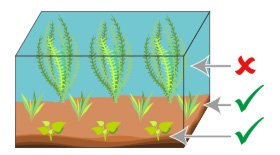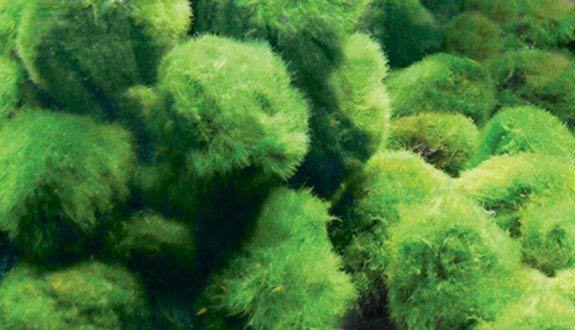

Alternative species (click on the thumbnail to see the card)
Names
Scientific name
Aegagropila linnaei
Cladophora linnae
Common name
Moss ball
Cladophora ball
Lake ball
Mossimo ball
Marimo
Origin

Origin: Japan, Europe, Southwest Asia, Australia
Ideal fertilization

CO2: 5-40mg/l
Nitrates (NO3): 10-50mg/l
Phosphates (PO4): 0,1-3mg/l
Potassium (K): 5-30mg/l
Iron (Fe): 0,01-0,5mg/l
Group

Cladophoraceae
Kind

Alga
Parameters

T°: 6 to 24°C or 43 to 72°F
pH: 6.5 to 7.5
Hardness: 2 to 20°dGH
Difficulty

Easy
Lighting

Average
Size

8 to 30 cm (3 to 12")
Plantation

Foreground and Middle
Growth

Slow
Presentation
Who is the Moss ball?
Presentation
Who is the Moss ball?
This species is very often considered as a moss or a plant, yet it is an alga!
It has long been a real success in our aquariums, but especially since the rise of freshwater shrimps, which are crazy about them!
It is particularly useful in the breeding tanks of many species: it will serve as a pantry and refuge for many fry and juvenile shrimp.
Planting and maintenance
How to plant and maintain the Moss ball?
Planting and maintenance
How to plant and maintain the Moss ball?
The Moss Ball is not demanding for the water parameters, except for the temperature which should not exceed 24°C or 75°F, or not too often (in case of hot summers for example).
It is perfect for beginners and requires very little maintenance. Note that it should be washed regularly because it gets dirty quickly (place it under the flow of the tap with a not too hot water then press it). Turn it over regularly so that all sides of the ball benefit from the lighting. This will help the foam to keep its pretty shape.
It can also be attached to different media to make a plant carpet.
It can reach up to 30 cm or 12 inches in diameter under intense lighting!
This alga will appreciate the diffusion of Co2, even if it is not an obligation.
Farming
How to farm the Moss ball?
Farming
How to farm the Moss ball?
Very easy. Just cut a piece of a big ball: you have a cuttings (which will naturally turn round with time)!
Good To know
Find all additional information!
Good To know
Find all additional information!
This species is very fond of nitrates and phosphates, and is also very popular with aquarists for that! Indeed, it will help maintain clean water and fight against the appearance of algae. Moreover, it is frequently called «anti nitrate ball». However, it should be remembered that this is not a miracle solution that will save you the water changes!
There are several varieties: Brownii, Bulnheimii, Daldinii, Holsatica, Linnaei, Martensii, Muscoides, Sauteri and Thermalis. The differences between these species are so tiny that they only stand out under a microscope!
Its spherical shape is not artificial: it is also in this form in its natural environment. It is due to the movements of the waves.
Yours photos!
Comments
Sort by:
Please login to post comments

